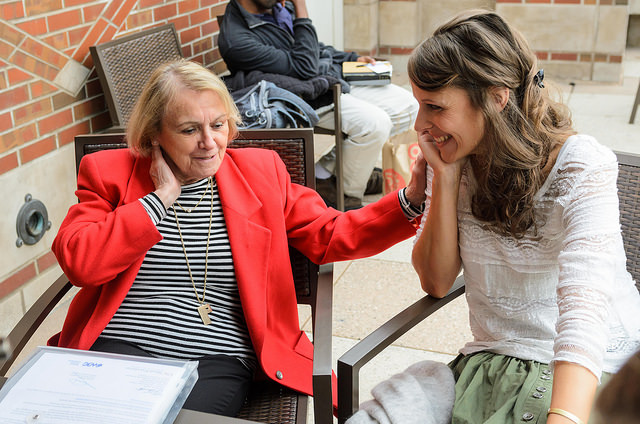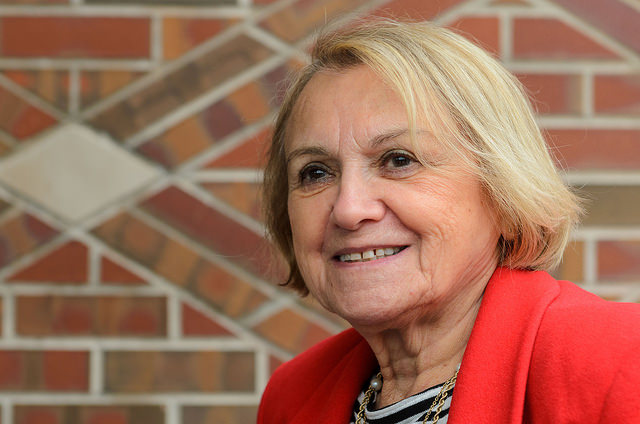‘Silence Is Never An Option’: The Uncomfortable Space Between Holocaust Fictionalization And Remembrance

Just two years after the release of “Schindler’s List" and one year after Steven Spielberg helped establish the USC Shoah Foundation, Lebovics shared her own story of growing up in a ghetto in German-occupied Poland, moving to work camp and eventually emerging from the looming gates of Auschwitz.
“On the general, I survived for one reason,” says Lebovics in the recording. “It’s because I think I was, I learned in my own head how to transport myself outside of there and I did, I did it daily. I did it all the time and I learned physically how to help myself survive.”
Almost two decades went by in which people responded to her testimony with the typical mixture of reverence and callousness that typically follows discussions of the Holocaust. But one day, 18 years after the initial recording, Lebovics received a letter that would spark a tremendous friendship.
“It is tempting to say that your testimony nearly broke my heart, for lack of a better phrase,” wrote Olga Burkhardt. “But I guess that’s not what happened when I saw your beautiful and soft face with that warm smile of yours, when I heard you recount what probably cannot be grasped in words, what cannot be conveyed, what simply resists comprehension…I promise you, Paula Lebovics, and I promise every single other survivor of the atrocities, crimes, and innumerable violations and breaches of the most basic human rights which my country, my forefathers committed, to dedicate every singe day of my life to brining up my child in a way that values life over death, friendship over betrayal, heart over reason, warmth over coldness, trust over mistrust, respect over humiliation, and tenderness over violence.”
SEE ALSO: Impact Of Genocide On Women: Conversation With Survivors
Now, a year after Burkhardt sent her letter and nine months after Lebovics first met her admirer at the annual March of the Living gathering in Auschwitz, the two women are once again reunited.
With a fifty year age gap between them, the German journalist and the Polish survivor of the Holocaust survivor certainly make an unlikely pair, but a single glance at the women—their hands clasped and smiling eyes—makes it clear how deep their bond is.
“I remember it was the middle of the night, it must have been 11:30, and I had finished working on my thesis for the night,” recalls Burkhardt who at the time had been working on her thesis about a contemporary Holocaust novel by Jonathan Safran Foer. “Even though [the testimony] is something like three hours, I ended up watching the whole thing; I just couldn’t stop listening to that woman with those sparkling eyes. I had a daughter who was the same age that Paula was when her whole ordeal began, and what she said just really moved me.”
Growing up in a post-World War II Germany, Burkhardt received an extensive education about the technicalities of the war and the rise of Nazi Party, but it classroom discussions centered around the numbers and the facts, not the people who lost their lives in the horrors of the Holocaust.
“I mean numbers are one thing, but I always felt that they deserved better. Even still I miss the stories,” says Burkhardt. “I miss the humanized experience in a way, but I guess that brings us back to literature—maybe that’s where literature comes into play.”
But Lebovics says in her testimony, “Living through it, I cannot make sense of anything that I went through,” a sentiment that makes Holocaust scholars and critics alike wonder how much people who did not live through the Holocaust can really hope to add to the depiction of the global horrors.

“‘Life is Beautiful" was such a degrading movie for me,” says Lebovics. “First of all, there is no way in this world that a child would have survived without being noticed. And second of all, the movie is almost making fun of it…It was a horrible picture to watch, so I never watched the others.”
Yet, even Lebovics acknowledges that much can come of telling the right narrative Holocaust narratives.
“’Schindler’s List’ was the first movie that really opened people’s eyes and that made people start talking. When I was watching that little girl in that red coat, it was like seeing a reflection of me and my life because I too was looking always for places to hide,” says Lebovics. “It told a real story about something that really happened, so it didn’t make it a fiction. To look it as a survivor, no matter how much you show, you cannot imagine what the reality was—at least from my point of view. But this was really the first movie that spoke to and woke up all of us survivors. It made us want to tell our stories.”
“And,” she adds with a smile, “when Steven Spielberg created the Shoah foundation, he gave us a voice.”
SEE ALSO: Jews Aren't Just Under Fire In The Middle East
Yet, much of the complexity of the issue lies in the fact that there is no true way to predict which retellings of the Holocaust will have succeed in enacting a worldwide change, and which will merely come off as offensive to Holocaust survivors and sympathizers alike. Martin Amis’s “The Zone of Interest” has been the most recent subjects of the historic debate, warranting discussion by such prolific literary voices such as Michiko Kakutani and Joyce Carol Oates.
“I think ever since the Holocaust, this debate has been going as to whether fiction should be regarded as a valid medium for people who are trying to narrate the past,” remarks Burkhardt. "But I guess that scholars have agreed that silence is not an option.”
“I’m very aware of the difficulties involved in fictionalization of a historical experience,” she continues. “But I guess for me, literature has helped me—I mean, I’m not trying to say that I understand anything, but it’s helped me in trying. And it’s not just writing it—it’s the memories too, even the autobiographies.”

“This is last generation to have survivors, so in generations to come, [the fictionalized accounts] are going to become the history,” says Lebovics. “History has been fictionalized forever, so I’m sure this is going to be taken the same way. But it feels good at least to know that [the Shoah Foundation] is going to preserve the history in such a way so that even if it’s fictionalized, the truth will still be out there. We are powerless, all we have is a voice right now for another minute and a half.”
SEE ALSO: Reaction Time: Keep Holocaust Denial Out Of The Curriculum
As Lebovics explains, a fabricated history began to be created within days of the liberation of the concentration camps. Even the photographs of her and other child inmates behind barbed wire depict a reality that was unknown to her in the days of imprisonment.
“We had hardly any clothes—not even underwear—even though there were mountains of clothes there in Auschwitz, as of course you can imagine,” says Lebovics. “And then with liberation, the Russians put these striped coats on us and took that photographs that you sill see in papers and in movies.”
“What Paula’s trying to say,” Burkhardt explains, “is that they were never dressed, so showing them in all the clothes betrays the truth.”
In a world where people continue to claim that “There's not one ounce of evidence for the fairytale homicidal gas chambers. NOT ONE WITNESS. No photo, no video, no autopsy, no chemical or biological evidence, no physical evidence, no circumstantial evidence. However, what we do have is numerous fraudulent witness testimony,” as one commenter wrote beneath Lebovics’s testimony, it becomes increasingly clear why it is absolutely imperative to keep the horrors of the Holocaust at the forefront of people’s memories.
“You are the future and you have a choice and you individually and collectively have to fight against things like distorting history,” says Lebovics. “With those things only you have the power, so if you see injustice, you have to take charge. You have a voice.”
The women share a tender smile, their hands still clasped, before Lebovics turns back to me. “There are problems, of course,” she says, “But silence is never an option.”
Contact Deputy Editor Sara Newman here and follow her on Twitter here.



